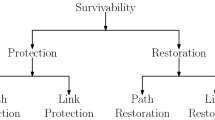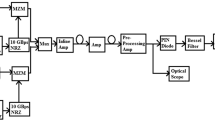Abstract
We propose a comprehensive design methodology for control and data planes of wavelength-routed optical networks (WRONs) employing mixed-line-rate (MLR) transmission for cost-effective resource provisioning. The proposed approach attempts to minimize the maximum lightpath capacity demand in Gbps (representing the measure of lightpath congestion) in network for a given traffic matrix by using a mix of a heuristic scheme and linear programming (LP). In the first step of the proposed three-step design, some lightpaths are set up on a set of judiciously selected fiber links (with point-to-point lightpaths between neighboring nodes), on a specific wavelength throughout the network, and an appropriate fraction of the same set of lightpaths is utilized for carrying control information, forming therefore the control plane (CP) of the WRON. The remaining bandwidth of these lightpaths is utilized to carry the data traffic along with all other designed lightpaths of the WRON using appropriate algorithm, forming the overall data plane (DP) of the WRON. In the second step, traffic routing is carried out through LP to minimize lightpath congestion in the network. In the third step, we utilize the results of LP to assign rates to lightpaths, such that the cost (considering only the transceiver cost) of the network is minimized. This design leads to congestion-aware MLR network with due consideration to cost-effectiveness without compromising the network restoration response against link failures. We carry out simulation studies employing possible CPs using both symmetric (CP topology being same as the physical topology) as well as asymmetric (using fewer fiber links than the symmetric case) topology. The results of our simulations indicate that the proposed design of CP with symmetric/asymmetric topology and in-band transmission with sub-lightpath capacity can bring down network congestion and cost with respect to symmetric out-of-band transmission (using fully reserved lightpaths for CP), without any perceptible sacrifice in respect of the network restoration time. Failure can occur either in CP or DP, or in both the planes. We investigate the effect of design of CP with symmetric/asymmetric topology on network restoration time for single- and double-link failures. We further present DP design methodology with hybrid restoration scheme, i.e., combination of dedicated (1:1) path protection and path restoration. We analyze the effect of symmetric CP topology and degree of protection on the congestion of the network. Some lightpaths, that support more traffic, are protected against failures, while the others are left for path restoration in the event of failures. As more lightpaths are protected, the congestion and power consumption of network increase. We provide an analysis of the factors that come into play while altering the degree of protection and observe how the choice for the degree of protection in DP can be arrived at using an appropriate design methodology.







Similar content being viewed by others
Notes
We do not consider wavelength conversion in this work.
References
Berthold, Joseph, et al.: Optical networking: past, present, and future. J. Lightwave Technol. 26(9), 1104–1118 (2008)
Mannie, E.: Generalized multi-protocol label switching architecture. In: IEFT RFC, vol. 3945 (2004)
Ruiz, M., Perello, J., Velasco, L., Spadaro, S., Comellas, J., Junyent, G.: GMPLS control plane network design with resilience guarantees. J. Lightwave Technol. 29(1), 37–47 (2011)
Jajszczyk, Andrzej, Rozycki, Pawel: Recovery of the control plane after failures in ASON/GMPLS networks. IEEE Netw 1(20), 4–10 (2006)
Farrel, Adrian, Bryskin, Igor: GMPLS: Architecture and Applications. Academic Press, London (2005)
Satyanarayana, A., Rahman. R.: Extensions to GMPLS resource reservation protocol (RSVP) graceful restart. In: RFC5063 (2007)
Ruepp, Sarah, Fagertun, A.M., Kosteas, V.: Strategies for optical transport network recovery under epidemic network failures. Photon. Netw. Commun. 29(3), 330–341 (2015)
Korniak, J., Rozycki, P.: Service availability analysis of GMPLS network. In: 2010 14th International Telecommunications Network Strategy and Planning Symposium (NETWORKS), 27–30 Sept 2010, pp. 1–5
Korniak, Janusz: The GMPLS controlled optical networks as industry communication platform. IEEE Trans. Ind. Inform. 7(4), 671–678 (2011)
Chen, Xiaoliang, et al.: Flexible availability-aware differentiated protection in software-defined elastic optical networks. J. Lightwave Technol. 33(18), 3872–3882 (2015)
Liu, L., et al.: Experimental demonstration of highly resilient wavelength-switched optical networks with a multivendor interoperable GMPLS control plane. J. Lightwave Technol. 30(5), 704–712 (2012)
Castro, A., et al.: Experimental assessment of bulk path restoration in multi-layer networks using PCE-based global concurrent optimization. J. Lightwave Technol. 32(1), 81–90 (2014)
Chen, Xiaoliang, et al.: Leveraging master–slave OpenFlow controller arrangement to improve control plane resiliency in SD-EONs. Opt. Express 23(6), 7550–7558 (2015)
Chandwani, G., Datta, D.: Comprehensive design for control and data planes in wavelength-routed optical networks. In: 2012 National Conference on Communications (NCC). IEEE (2012)
Nag, Avishek, Tornatore, Massimo: Optical network design with mixed line rates. Opt. Switch. Netw. 6(4), 227–234 (2009)
Nag, A., Tornatore, M., Mukherjee, B.: Optical network design with mixed line rates and multiple modulation formats. J. Lightwave Technol. 28(4), 466–475 (2010)
Chowdhury, P., Tornatore, M., Nag, A., Ip, E., Wang, T., Mukherjee, B.: On the design of energy-efficient mixed-line-rate (MLR) optical networks. J. Lightwave Technol. 30(1), 130–139 (2012)
Goswami, Partha, Ghosh, Soumya K., Datta, Debasish: On methodologies to estimate optical-layer power consumption and cost for long-haul WDM networks with optical reach constraint. Photon. Netw. Commun. 29(1), 12–31 (2014)
Morat, Daniel, et al.: On capacity planning for the GMPLS network control plane. Photon. Netw. Commun. 15(2), 159–169 (2008)
Casellas, R., Munoz, R., Martinez, R., Vilalta, R., Mayoral, A., Lei, Liu, Tsuritani, T., Morita, I.: Overarching control of flexi grid optical networks: interworking of GMPLS and OpenFlow domains. J. Lightwave Technol. 33(5), 1054–1062 (2015)
Casellas, Ramon, et al.: Design and experimental validation of a GMPLS/PCE control plane for elastic CO-OFDM optical networks. IEEE J. Sel. Areas Commun. 31(1), 49–61 (2013)
Knuth, D.E.: The Art of Computer Programming, Volume 4, Fascicle 1: Bitwise Tricks & Techniques; Binary Decision Diagrams. Addison-Wesley Professional (2009)
Ramaswami, R., Sivarajan, K.N.: Design of logical topologies for wavelength-routed optical networks. IEEE J. Sel. Areas Commun. 14(5), 840–851 (1996)
Berger, L.: Generalized multi-protocol label switching (GMPLS) resource reservation protocol-traffic engineering (RSVP-TE) extensions. In: IEFT RFC, vol. 3473 (2003)
Giorgetti, A., Sambo, N., Cerutti, I., Andriolli, N., Castoldi, P.: Label preference schemes for lightpath provisioning and restoration in distributed GMPLS networks. J. Lightwave Technol. 27(6), 688–697 (2009)
Muoz, R., Martinez, R., Casellas, R.: Challenges for GMPLS lightpath provisioning in transparent optical networks: wavelength constraints in routing and signaling. IEEE Commun. Mag. 47(8), 26–34 (2009)
Velasco, L., Agraz, F., Martíandnez, R., Casellas, R., Spadaro, S., Muñ andoz, R., Junyent, G.: GMPLS-based multidomain restoration: analysis, strategies, policies and experimental assessment. IEEE/OSA J. Opt. Commun. Netw. 2(7), 427–441 (2010)
Clouqueur, M., Grover, W.D.: Availability analysis of span-restorable mesh networks. IEEE J. Sel. Areas Commun. 20(4), 810–821 (2002)
Simmons, Jane M.: Optical Network Design and Planning. Springer, Berlin (2014)
Shen, G., Tucker, R.S.: Energy-minimized design for IP over WDM networks. IEEE/OSA J. Opt. Commun. Netw. 1(1), 176–186 (2009)
Jirattigalachote, A., Cavdar, C., Monti, P., Wosinska, L., Tzanakaki, A.: Dynamic provisioning strategies for energy efficient WDM networks with dedicated path protection. Opt. Switch. Netw. 8(3), 201–213 (2011)
Author information
Authors and Affiliations
Corresponding author
Rights and permissions
About this article
Cite this article
Chandwani, G., Sen, R. & Datta, D. Comprehensive design methodology for control and data planes in wavelength-routed optical networks. Photon Netw Commun 33, 243–257 (2017). https://doi.org/10.1007/s11107-016-0649-9
Received:
Accepted:
Published:
Issue Date:
DOI: https://doi.org/10.1007/s11107-016-0649-9




